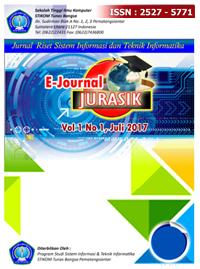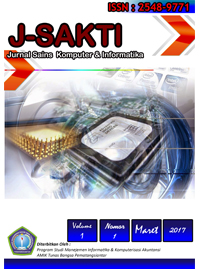Perengkingan Pengetahuan Dalam Time Series Data Mining dengan J-Measure
Abstract
Full Text:
PDFReferences
J. Han, M. Kamber, and J. Pei, Data Mining Concepts and Techniques, Third Edit., vol. 1. Elsevier, 2012.
J. Lin, S. Lonardi, J. Lin, and S. Lonardi, “Visualizing and Discovering Non-Trivial Patterns In Large Time Series Databases Short running title : Time Series Visualization Visualizing and Discovering Non-Trivial Patterns In Large Time Series Databases,” 2005.
S. Rodpongpun, V. Niennattrakul, and C. A. Ratanamahatana, “Selective Subsequence Time Series clustering,” Knowledge-Based Syst., vol. 35, pp. 361–368, 2012.
J. Serr, “Ranking and significance of variable-length similarity-based time series motifs ´,” 2015.
A. Mueen, S. Cash, and B. Westover, “Exact Discovery of Time Series Motifs,” 2002.
N. Castro and P. J. Azevedo, “Time Series Motifs Statistical Significance,” 2008.
R. Fujimaki, S. Hirose, and T. Nakata, “Theoretical analysis of subsequence time-series clustering from a frequency-analysis viewpoint,” Sdm Siam, no. Figure 1, pp. 506–517, 2008.
U. Ramer, “An Iterative Procedure for the Polygonal Approximation of Planar Curves. Computer Graphics and Image Processing,” pp. 244–256, 1972.
M. Heckbert, P.S. and Garland, “Survey of Polygonal Surface Simplification Algorithms, Multiresolution Surface Modeling Course.,” 1997.
K. U. Yoshiki Tanaka, Kazuhisa Iwamoto, “Discovery of Time-Series Motif from Multi-Dimensional Data Based on MDL Principle,” Springer Sci. + Bus. Media, Inc. Manuf. Netherlands, no. 2000, pp. 269–300, 2005.
DOI: http://dx.doi.org/10.30645/senaris.v1i0.130
Refbacks
- There are currently no refbacks.
 








